Enterprise Recon 2.0.31
Server Information
This section covers the following topics:
Master Server Details
The Server Information page displays the following information about the Master Server:
| Section | Displays |
|---|---|
| Master Host/ Master Version/ Master Public Key |
|
| Server Time | Displays Master Server system clock.
Scan schedules by default depend on your Master Server's system clock. If your Master Server's system clock does not match a Node Agent's system clock, your scans will not run as scheduled. To change the time shown here, access the Master Server and change its system clock. |
| Backup | Displays the active backup policy and the status of recent backups.
See Automated Backups. |
| System Load | Displays the Master Server system load.
See System Load Graph. |
| System Services | Displays the status of system services on the Master Server. |
Automated Backups
To create an automated backup policy:
- Log into the Web Console.
-
Expand the navigation menu, ENTERPRISE RECON
 .
. - On the Server Information page, go to the Backup section and click the Edit icon.
- Select Enable auto-backup and click Confirm.
-
In the Edit Backups dialog box, fill in the following fields:
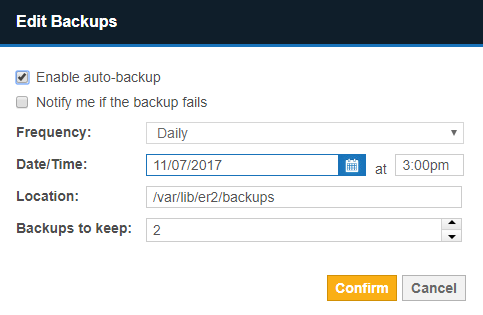
Field Description Enable auto-backup Select to begin configuring the automatic backup policy. Notify me if the backup fails Sets up a new notification policy in MONITORING AND ALERTS > NOTIFICATIONS AND ALERTS. Frequency Select frequency of automatic backup jobs Date/ Time Select date and time of the next automatic backup job. Location Enter the location on the Master Server where automatic backups are stored. Backups to keep Enter the maximum number of backups the Master Server stores.
If there are more backups stored than the maximum, the Master Server removes the oldest backups. - Click Confirm to create the automatic backup policy. The "Backup" section now displays the details of your automatic backup policy.
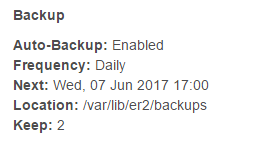
Do not restart the Master Server when a backup job is in progress. You cannot resume an interrupted backup job.
If there is less than 50% free disk space available on the Master Server, the automatic backup policy will pause itself. Automatic backups will resume when the Master Server detects that there is more than 50% free disk space available.
Backup Status
A list of backup jobs are displayed under the backup policy details. The jobs have the following statuses:
- COMPLETED: Completed backup jobs are stored on the Master Server, in the path displayed under the "Location" column.
- PENDING: Backup jobs that are waiting to start.
- RUNNING: Backup jobs that are in progress.
- INTERRUPTED: Backups are interrupted when the Master Server restarts mid-job. You cannot resume an interrupted backup.
- ERROR: Backup jobs that have encountered an error and cannot continue.

Delete Backups
To delete backups:
- Hover over the backup entry. Delete appears to the right of the backup entry.
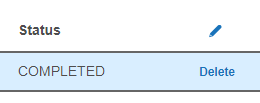
- Click Delete.
- Click Confirm to permanently delete the backup.
Restoring Backups
For details on restoring backups from the Master Server console, see Restoring Backups.
System Load Graph
On the MONITORING AND ALERTS > Server Information page, you can view a graph of the Master Server system load against time.
The graph’s legend indicates the system load type shown and the corresponding color on the graph.
To view and download a log of the system load statistics in a CSV file format, click Download Statistics.

To view details on a statistic, pause on a point on the line graph to view the statistic utilization percentage and the exact time stamp.
For example, the above image displays the memory usage for Wed, Jun 21 at 14:23.
Reading the Graph
The following table describes the statistics shown for both the graph and CSV file:
| Graph value | CSV column | Description |
|---|---|---|
| (x axis) | Time stamp | The system load's statistics are recorded every 10 seconds. Statistics older than an hour are then averaged down to hourly records. In the CSV file, the records are sorted from oldest to newest. |
| CPU | CPU Usage % | CPU usage refers to your computer’s processor and how much work it's doing. A high reading means your computer is running at the maximum level or above normal level for the number of applications running. |
| Memory | Memory Usage % | Percentage of memory used to run the processes on the Master Server. |
| Disk | Disk Usage % | Percentage of disk space that is currently in use on the Master Server. |
| I/O | Disk I/O % | Any operation, program, or device that transfers data to or from a computer. Typical I/O devices are printers, harddisks, keyboards and mouses. |
Customize the Graph
You can toggle the visibility of each statistic charted on the graph. By default, all the line graphs are shown.
To hide a statistic, click the statistic's line graph or the statistic type in the legend. When hidden, the statistic type in the legend is dimmed.

To view statistics for a set date or time period:
- Go to the System Load Graph. Move your mouse to the desired start date.
- Click and drag the mouse to the desired end date.
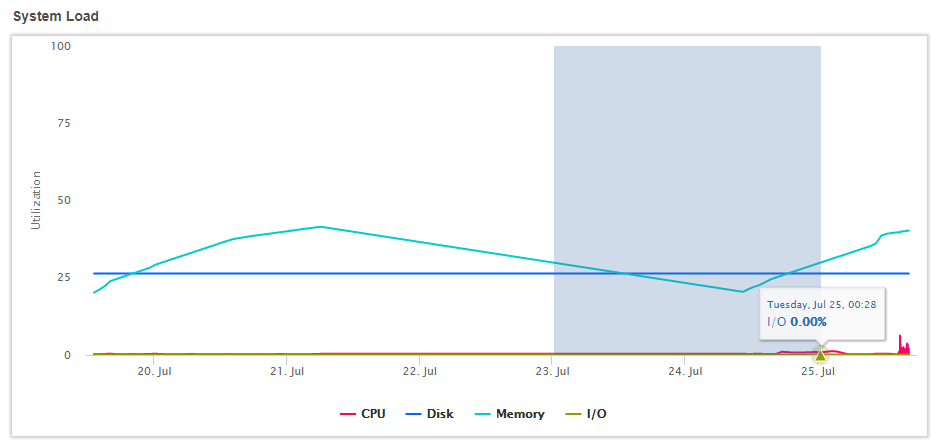
- To return to the original graph, click Reset zoom.
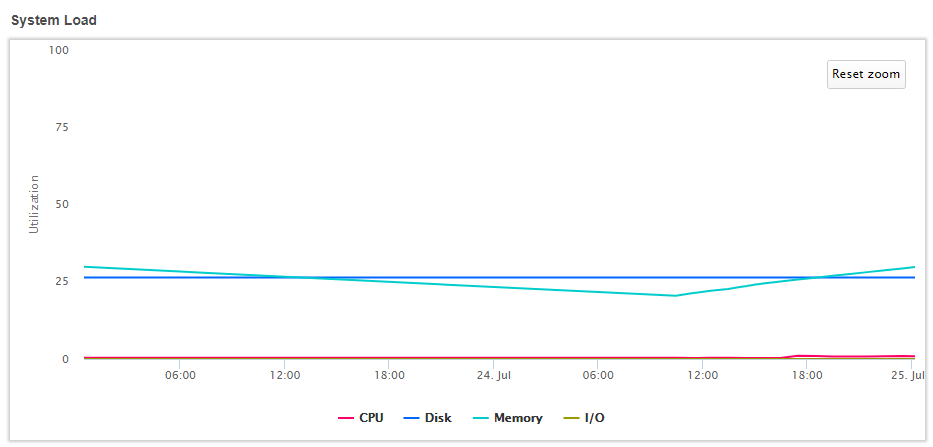
Shutdown Server
Click Shutdown Server to completely shut down the Master Server.

This has the same effect as running shutdown -h now in the Master Server console. The Master Server may take a while to completely shut down.
Shutting down the Master Server also makes the Web Console unavailable. You need physical access to the Master Server to start it again.
Current scans and scheduled scans will continue to run while the Master Server is offline.
If full disk encryption was enabled when installing the Master Server, you have to enter the passphrase when starting the Master Server.
See Install the Master Server for more information.